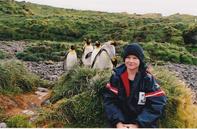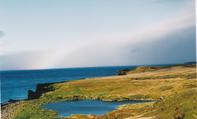
Formation of the Prince Edward Islands
Life Above Sea Level
Leonie Joubert on Marion Island with King Penguins.
“I was offered a rare opportunity to board the SA Agulhas and travel down to the Prince Edward Islands in the sub-Antarctic where South Africa has a meteorological station. My mandate was to follow some of the work of a group of climate change researchers. There I discovered a place so entirely removed from the world we know here, with its littered pavements, congested highways and mono-crop agriculture. This remote mound of volcanic rock, poking out of the ocean and blasted year round by the ferocious westerly winds, is one of the few inaccessible wildernesses left on Earth. But even here the effects of pollution from half-way across the planet are changing the face of the islands.” - Leonie Joubert.
Both Prince Edward and Marion Islands started life above sea level as little more than a giant pumice stone-barren, cold and harassed by the elements. The first visitors were transient - seals and penguins arriving by sea, and albatrosses, gull-like skuas and petrels by air. Their stay on these inhospitable rocks would have been short-lived because, as yet, they offered little more than a place to catch their breath.
Sub-Antarctic Garden
Marion Island covered in mosses, lichens and grasses.
With time, and assisted by the passing visits of these travellers, the first immigrants made landfall at Marion Island. Plants arrived on the underbellies of birds or clinging to driftwood. Some, like pioneering Azorella selago and some mosses, colonised the nutrient-poor volcanic ash, scoria and rock despite their constant freeze-thaw cycles, ravaging winds and perennial rain. Other plants - mosses, lichens and grasses - would eventually arrive and also put down roots. Tiny creatures just visible to the naked eye - mites, springtails and weevils, and some not visible to the naked eye - like the moss-loving water bears (tardigrades), would have taken up residence in any habitable plant matter they could find. Over thousands of years, the natural growth and death cycles of these creatures, along with the constant raw edge of the elements' relentless pounding, enabled enough organic material to accumulate to plug up the porous rocks and allow fresh water to gather: the beginning of a sub-Antarctic garden. Marion Island and its smaller sibling are geological newborns.
Compared with ancient ecosystems on the mainland, these environments are gasping their first breaths and consist of little more than an apron of peaty mires around the coast, drier fern slopes, some grassy patches, and a polar desert further inland. To science, the beauty of Marion is beyond the obvious green, rolling hills of the lowlands and the wild, rocky interior. Its remote habitat and the simplicity of its ecosystem make it easier to understand than the much more complex workings of older ecosystems where many more tiers of life mingle in intricate and complicated ways.
By Leonie Joubert

